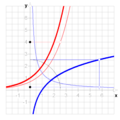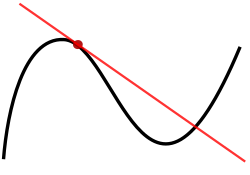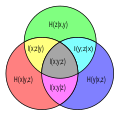In calculus, the chain rule is a formula that expresses the derivative of the composition of two differentiable functions f and g in terms of the derivatives...
38 KB (7,087 words) - 05:29, 7 June 2025
Integration by substitution (redirect from Inverse chain rule method)
reverse chain rule or change of variables, is a method for evaluating integrals and antiderivatives. It is the counterpart to the chain rule for differentiation...
20 KB (3,328 words) - 18:12, 21 May 2025
In probability theory, the chain rule (also called the general product rule) describes how to calculate the probability of the intersection of, not necessarily...
9 KB (2,359 words) - 02:27, 24 November 2024
Chain rule may refer to: Chain rule in calculus: d y d x = d y d u ⋅ d u d x . {\displaystyle {\frac {\mathrm {d} y}{\mathrm {d} x}}={\frac {\mathrm {d}...
733 bytes (237 words) - 20:43, 8 March 2011
portal Chain rule Differentiation of integrals Leibniz rule (generalized product rule) Reynolds transport theorem, a generalization of Leibniz rule Protter...
53 KB (11,253 words) - 03:22, 22 June 2025
In calculus, the product rule (or Leibniz rule or Leibniz product rule) is a formula used to find the derivatives of products of two or more functions...
21 KB (4,278 words) - 22:08, 17 June 2025
g(x)-1\cdot g'(x)}{g(x)^{2}}}={\frac {-g'(x)}{g(x)^{2}}}.} Utilizing the chain rule yields the same result. Let h ( x ) = f ( x ) g ( x ) . {\displaystyle...
7 KB (1,879 words) - 03:09, 20 April 2025
Jacobi's formula (section Via chain rule)
(A_{11},A_{12},\ldots ,A_{21},A_{22},\ldots ,A_{nn})} so that, by the chain rule, its differential is d det ( A ) = ∑ i ∑ j ∂ F ∂ A i j d A i j . {\displaystyle...
10 KB (1,979 words) - 10:47, 24 April 2025
Conditional entropy (section Chain rule)
It has a similar form to chain rule in probability theory, except that addition instead of multiplication is used. Bayes' rule for conditional entropy...
11 KB (2,142 words) - 15:57, 16 May 2025
\theta \,.} To compute the derivative of the cosine function from the chain rule, first observe the following three facts: cos θ = sin ( π 2 − θ )...
19 KB (3,679 words) - 01:25, 25 February 2025
and is therefore an instance of a vector-valued differential form. The chain rule has a particularly elegant statement in terms of total derivatives. It...
15 KB (2,711 words) - 02:26, 2 May 2025
{df}{dx}}.} The reciprocal rule can be derived either from the quotient rule or from the combination of power rule and chain rule. If f {\textstyle f} and...
18 KB (2,820 words) - 03:07, 20 April 2025
( y ) = x {\displaystyle f^{-1}(y)=x} in terms of x and applying the chain rule, yielding that: d x d y ⋅ d y d x = d x d x {\displaystyle {\frac {dx}{dy}}\...
9 KB (1,789 words) - 13:15, 27 April 2025
Vector calculus identities (section Chain rule)
vector field. We have the following special cases of the multi-variable chain rule. ∇ ( f ∘ ϕ ) = ( f ′ ∘ ϕ ) ∇ ϕ ( r ∘ f ) ′ = ( r ′ ∘ f ) f ′ ( ϕ ∘ r )...
40 KB (6,570 words) - 12:32, 20 June 2025
The triple product rule, known variously as the cyclic chain rule, cyclic relation, cyclical rule, Euler's chain rule, or the reciprocity theorem, is a...
11 KB (1,819 words) - 07:47, 19 June 2025
{\displaystyle f'(x)=f(x)=e^{x}} , as was required. Therefore, applying the chain rule to f ( x ) = e r ln x {\displaystyle f(x)=e^{r\ln x}} , we see that...
13 KB (2,643 words) - 14:25, 25 May 2025
in computing parameter updates. It is an efficient application of the chain rule to neural networks. Backpropagation computes the gradient of a loss function...
55 KB (7,843 words) - 14:53, 20 June 2025
Wirtinger derivatives (section Chain rule)
one and several complex variables: for the n > 1 case, to express the chain rule in its full generality it is necessary to consider two domains Ω ′ ⊆ C...
33 KB (4,468 words) - 18:40, 2 January 2025
and elementary functions (exp, log, sin, cos, etc.). By applying the chain rule repeatedly to these operations, partial derivatives of arbitrary order...
44 KB (6,146 words) - 08:53, 12 June 2025
respect to time or one of the other variables requires application of the chain rule, since most problems involve several variables. Fundamentally, if a function...
10 KB (1,674 words) - 09:58, 3 January 2025
Fisher information (section Chain rule)
and therefore ∫ f d x = 1 {\displaystyle \int f\,dx=1} . By using the chain rule on the partial derivative of log f {\displaystyle \log f} and then dividing...
52 KB (7,376 words) - 12:50, 8 June 2025
rules Derivative of a constant Sum rule in differentiation Constant factor rule in differentiation Linearity of differentiation Power rule Chain rule...
4 KB (389 words) - 12:14, 10 February 2024
Derivative (section Rules of computation)
functions. For constant rule and sum rule, see Apostol 1967, pp. 161, 164, respectively. For the product rule, quotient rule, and chain rule, see Varberg, Purcell...
58 KB (7,409 words) - 21:41, 29 June 2025
different operations, as can be seen when considering differentiation (chain rule) or integration (integration by substitution). A very simple example of...
14 KB (2,691 words) - 10:02, 21 October 2024
Itô's lemma (redirect from Ito's rule)
stochastic process. It serves as the stochastic calculus counterpart of the chain rule. It can be heuristically derived by forming the Taylor series expansion...
28 KB (5,921 words) - 04:54, 12 May 2025
) {\displaystyle I(X;Y|Z)=I(X;Y,Z)-I(X;Z)} usually rearranged as the chain rule for mutual information I ( X ; Y , Z ) = I ( X ; Z ) + I ( X ; Y | Z )...
11 KB (2,385 words) - 15:00, 16 May 2025
Tensor field (section Cocycles and chain rules)
an advanced explanation of the tensor concept, one can interpret the chain rule in the multivariable case, as applied to coordinate changes, also as the...
26 KB (4,401 words) - 20:56, 18 June 2025
a ) . {\displaystyle \nabla (fg)(a)=f(a)\nabla g(a)+g(a)\nabla f(a).} Chain rule Suppose that f : A → R is a real-valued function defined on a subset A...
37 KB (5,689 words) - 00:23, 24 June 2025
main benefit of the Stratonovich integral is that it obeys the usual chain rule and therefore does not require Itô's lemma. This enables problems to be...
5 KB (620 words) - 23:30, 1 July 2025
Stratonovich integral as an alternative formulation; it does follow the chain rule, and does not require Itô's lemma. The two integral forms can be converted...
31 KB (4,554 words) - 03:50, 6 May 2025









